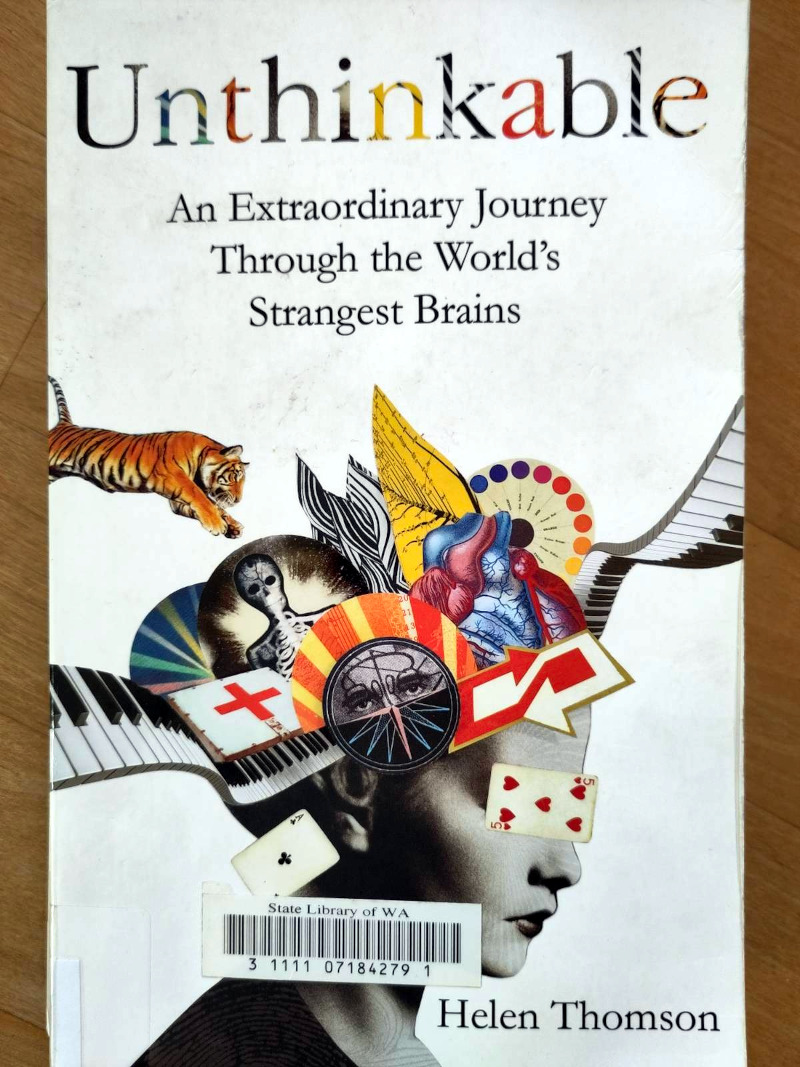Book review - Unthinkable - An Extraordinary Journey Through the World's Strangest Brains by Helen Thomson
feed books psychology robotics AI intelligence computational ethology evolution brain Summary review

Unthinkable is a 2018 book by Helen Thomson which looks at nine different people and their brains.
Human brains are not all alike, That much is clear to everyone. What is less clear, is the sheer amount of how different they can actually be. All the time still being OK brains, each, in the sense of that they cope. People’s body heights for example are also different, but the amount they differ by is limited. There are no people that are 10cm or 3m in height. With brains, this is not so. While there is something like roughly similar ‘normal’ brains for many people, there are also wildly differing brains and there is hardly any limit on how different from the majority any single brain can be.
As such, it is a story about diversity, and diversity in as extreme a form as it possibly gets. It highlights nine individuals with very specific and rare conditions affecting their brains, and thus, their experience of themselves and the world. Tons of psychology and neuroscience lessons for use in robotics included for free.
Conditions include 1/ not forgetting, 2/ loss of location, 3/ synaesthesia (auras), 4/ switching personalities, 5/ constant hallucination (audio), 6/ becoming a tiger, 7/ becoming unreal, 8/ waking up dead, 9/ feeling other people’s pain. For all the details I refer you to the book itself. Instead, let’s pick a few gems of insight and narrative and comment on them.
Selected and annotated quotes
Maybe it is still better to read a book on paper, make less highlights and just have fewer problems?
85/86 synaesthesia, Vilayanur Ramachandran, round blob vs. jagged piece, naming them bouba vs kiki
In this experiment on synaesthesia the close relationship between perception of shape and sound or language comes to the front. Love it.
96 the dress. a classical example. straightforward indication of two entirely equally valid modes of perception, prevalent in the population. Beside the two main modes, there is a few lower but equally stable side modes, too.
I have seen this come through back then but wasn’t so impressed as this time round. The picture is really very good and-just-works for everyone I have shown it to. Myself I seem to be able to see both black/blue and white/gold while others always see it in the same colors.
143 David Rosenhan, 1973 experiment, schizophrenia psychiatry admission experiment
Even if the Rosenhan’s rigor in that study is subject to veritable criticism, the idea is interesting and it certainly just makes for a great story.
145 Ganzfeld technique sensory deprivation, ping pong balls on eyes and white noise on the headphones.
Very interesting sensory deprivation experimental technique. I have heard about this one previously, have tried it once I think but found it stupid at that time and didn’t get good results because probably I just was too impatient. Things to do.
146 Oliverc Sacks, the brain doesn’t tolerate inactivity
Oliver Sacks is well known and just putting some more matter on the the sensory deprivation technique of creating hallucinations, this is a crisp way of putting it. If in a deprived state without any changes in stimulation, the brain amplifies its own random fluctuations into fully fledged but spurious experiences.
161 Schizophrenia is one of the most complex of human disorders affecting 1 in 100 persons.
Noteworthy phenomeno and noteworthy numbers. Given Dunbar’s number as a reference (probably suboptimal choice), that means each of us know’s one and a half people affected by schizophrenia.
191-197 Interoception & all related
This is a bit terse. It highlights in detail the essential importance of interoception for a passable experience of self at all. Need to go back for details but don’t have access to the book right now.
213 Seth, Chinese woman brain scan entire cerebellum is missing
This year I met a cat (Earl) that was said to have no cerebellum, and that cat was certainly moving in a weird way. It quite took me that there also is people with that condition, so I researched this particular fact. Also note the man with only 10% of his brain below.
- A new case of complete primary cerebellar agenesis: clinical and imaging findings in a living patient, https://academic.oup.com/brain/article/138/6/e353/269537
- This Woman Lived 24 Years Without Knowing She Was Missing Her Entire Cerebellum, https://www.sciencealert.com/this-woman-lived-24-years-without-knowing-she-was-missing-her-entire-cerebellum
- Woman of 24 found to have no cerebellum in her brain, https://www.newscientist.com/article/mg22329861-900-woman-of-24-found-to-have-no-cerebellum-in-her-brain/
- An adult woman was found to be missing her cerebellum, https://www.washingtonpost.com/news/speaking-of-science/wp/2014/09/11/an-adult-woman-was-found-to-be-missing-her-cerebellum/
- Related: Meet The Man Who Lives Normally With Damage to 90% of His Brain, https://www.sciencealert.com/a-man-who-lives-without-90-of-his-brain-is-challenging-our-understanding-of-consciousness?:_sciencealert-lates___=
218 default mode network
I just love the default mode network and note down every single reference I find to it. You should check out the default mode network if you haven’t.
246 Compassion training to overcome empathy, willfully extend warm feelings towards everyone in the environment
Suffering from a bit of over-empathisizing usually I found it interesting to again learn about the distinction between compassion and empathy, and then, that you can train for compassion in favor of empathy.
References
eot
Comments
tag cloud
robotics music AI books research psychology intelligence feed ethology computational startups sound jcl audio brain organization motivation models micro management jetpack funding dsp testing test synthesis sonfication smp scope risk principles musician motion mapping language gt fail exploration evolution epistemology digital decision datadriven computing computer-music complexity algorithms aesthetics wayfinding visualization tools theory temporal sustainability supercollider stuff sonic-art sonic-ambience society signal-processing self score robots robot-learning robot python pxp priors predictive policies philosophy perception organization-of-behavior open-world open-culture neuroscience networking network navigation movies minecraft midi message-passing measures math locomotion linux learning kpi internet init health hacker growth grounding graphical generative gaming games explanation event-representation embedding economy discrete development definitions cyberspace culture creativity computer compmus cognition business birds biology bio-inspiration android ai agents action